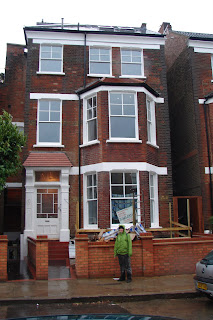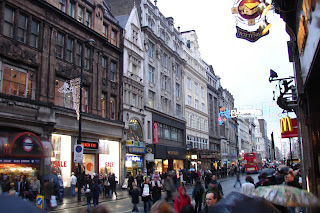
From November 1838 to April 1839 he attended nineteen of twenty lectures on 'Nathology (?) and the Practice of Medicine'
and from 1st May to July 27th 1839 he attended a ten part course on 'Practical Chemistry and Pharmacy'. Both these were given by William Reid.
Allan Borman took two anatomy courses. Both consisted of twenty sessions, the first between 4th November 1837 and 23rd April 1838, the second between 6th November 1838 and 26th April 1839. These took place at Robert Knox's private Anatomy School in Surgeon's Square (pictured). Knox was infamous for the role he played in receiving the murder victims of Burke and Hare. Between 1827-28 the pair, after selling on a pensioner who had died at Hare's lodging house, murdered a total of seventeen victims, each one bought by Knox. On two occassions students on Knox's course recognised the cadavers. Knox denied the bodys' identities but on one such corpse started the dissection with the face just to stop further interjections.
Knox was infamous for the role he played in receiving the murder victims of Burke and Hare. Between 1827-28 the pair, after selling on a pensioner who had died at Hare's lodging house, murdered a total of seventeen victims, each one bought by Knox. On two occassions students on Knox's course recognised the cadavers. Knox denied the bodys' identities but on one such corpse started the dissection with the face just to stop further interjections.
Hare later testified against Burke who was executed and himself used for medicial dissection. A note book bound with Burke's skin can still be seen at the Royal College of Surgeons in Edinburgh. 
Friday, 28 December 2007
Borman and the Body Snatcher
Posted by
Simon
0
comments
![]()
Labels: Allan Borman, Mary Jane Elizabeth Brooks
Revisiting Hornsey and Holborn

The first stop was a building site in Hornsey Rise Gardens. The Brooks family's old home was first given permission to divide in 1978. Then it was into three flats now, in 2007, it is five. To help achieve this the earth around the basement has been removed and the whole garden re landscaped.
My Grandfather, William Vincent Brooks, recalls visiting Granny Brooks at the house and how Frederick, his grandfather, had purchased a strip of land to the rear of the garden that ran along the top of the now disused railway embankment. This was the perfect play area for Frederick's four boys.
Next stop on the trip was Oxford Street. Since John Brooks first started business in 1813 the buildings have of course changed and been redeveloped at least twice.
Frederick describes his Grandfather's business to have been, 'just opposite to the Western end of where Frascati’s now stands'. If our detective work is correct Frascati's was next door to the Oxford Music Hall which is now occupied by the Virgin Mega Store. This places John Brooks somewhere near the top of Soho street. Just across the road is Rathbone Place home of the future Wybrow inlaws.
Kings Street was left for another visit as was Chandos Place.
Moving along to Holborn we came to Parker Street. Knowing that the the firm had been bombed out during the war, we did not expect to find very much but it was worth a look. Indeed the majority of the street seems to be post war although the buildings on the south side at the western end give a taste of it's previous industrial character. Unlike the office block that stands where number 48 once was, one of the new developments pictured, shares many features with the old Brooks building. Just across Kingsway we find the narrow entrance to Gate Street. This was the original home of Day & Son. Having gone into liquidation in 1868 the company was purchased by Vincent Brooks forming 'Vincent Brooks, Day & Son'.
Just across Kingsway we find the narrow entrance to Gate Street. This was the original home of Day & Son. Having gone into liquidation in 1868 the company was purchased by Vincent Brooks forming 'Vincent Brooks, Day & Son'.
The centre section of the building has been rebuilt, presumably after war damage, but both ends remains the same. The northern part is now Pu's Brasserie while the south section is home to the Barristers of the Holborn Chambers. An old illustration of Gate Street can be found in 'The Business' post blow. It was dark by the time we arrived late on that winter's afternoon, the narrowness of the street also made a good photograph of the whole building difficult. At least we have an excuse to return and maybe sample one of Pu's coffees.
Posted by
Simon
0
comments
![]()
Labels: lithography, printing, Vincent Brooks Day and Son
Saturday, 22 December 2007
Educating Good Taste and Art in Industry
 On Monday 29th April 1935 Wilfred Vincent Brooks gave a speech to the Lincolnshire branch of the National Council of Women. Having served as chairman of the Commerical Printing Section of the Royal Academy of Art's 'British Art in Industry' exhibition earlier that year he gave a luncheon talk entitled:
On Monday 29th April 1935 Wilfred Vincent Brooks gave a speech to the Lincolnshire branch of the National Council of Women. Having served as chairman of the Commerical Printing Section of the Royal Academy of Art's 'British Art in Industry' exhibition earlier that year he gave a luncheon talk entitled:
"How Improved Art in Industry can help to conquer Ugliness and add to the Happiness of our fellow countrymen."
As the article is lengthy we have posted it here. The paragraph below is just a taster...
"The day, I hope, will come when quality and quantity will come together in happy alliance and the most ordinary commodities will benefit in form as well as in substance. Ugliness is at all times and in all places to be vigorously rejected; it is a coarsening and debasing influence, a clear sign of deterioration in a nations life. Since the products of industry are so widespread amongst the people, there influence for a good or evil condition of taste is immense. Hence the conquest of ugliness is of even greater moment in industry than elsewhere."
Posted by
Simon
0
comments
![]()
Labels: Art and Industry, Good Taste, Modernism, Wilfred Vincent Brooks
Sunday, 2 December 2007
Looking to Learn about Lithography?
 Want to know a little more about this 'lithography' thing that you keep reading about on this site? Nowadays the internet is an amazing source of information on just about any subject you can imagine. Just ten years ago we would have had to spend much time visiting libraries or seaching through archives. One of the many useful sources may have been an encyclopedia, none more well-known than the Encyclopedia Britannica. If we had followed this course, and happened upon the 1911 edition, we would have discovered an entry on Lithography written by none other than Frederick himself which you can read here. The 'LoveToKnow' site we have linked to states that many consider "the best encyclopedia ever written:[to be] the eleventh edition of the Encyclopaedia Britannica, first published in 1911. At a time when many encyclopedias have capsulated and condensed important knowledge, the 11th edition is generally much more in-depth and thorough on its topics.
Want to know a little more about this 'lithography' thing that you keep reading about on this site? Nowadays the internet is an amazing source of information on just about any subject you can imagine. Just ten years ago we would have had to spend much time visiting libraries or seaching through archives. One of the many useful sources may have been an encyclopedia, none more well-known than the Encyclopedia Britannica. If we had followed this course, and happened upon the 1911 edition, we would have discovered an entry on Lithography written by none other than Frederick himself which you can read here. The 'LoveToKnow' site we have linked to states that many consider "the best encyclopedia ever written:[to be] the eleventh edition of the Encyclopaedia Britannica, first published in 1911. At a time when many encyclopedias have capsulated and condensed important knowledge, the 11th edition is generally much more in-depth and thorough on its topics.
It is not uncommon for its entries to be 5 to 10 times the length of other encyclopedias. As a research tool, this 11th edition is unparallelled - even today.
The Eleventh Edition filled 29 volumes and contains over 44 million words. It contains over 40,000 articles written by over 1,500 authors within their various fields of expertise. What was particularly remarkable was that many of the entries were written by the most famous people of the age. As such, it was considered to represent the sum of human knowledge at the beginning of the 20th Century."
A handwritten copy of the entry (see picture) was also found amongst Frederick's documents. At first we thought these papers might be a speech or draft of a journal article. Finding the 1911 Encyclopedia Britannica online, as we had during many internet searches, we noticed the tell-tale F.V.B. signature and put two and two together. The online text matches the hand script which Frederick wrote in 1907.
Posted by
Simon
0
comments
![]()
Labels: Frederick Vincent Brooks, lithography


